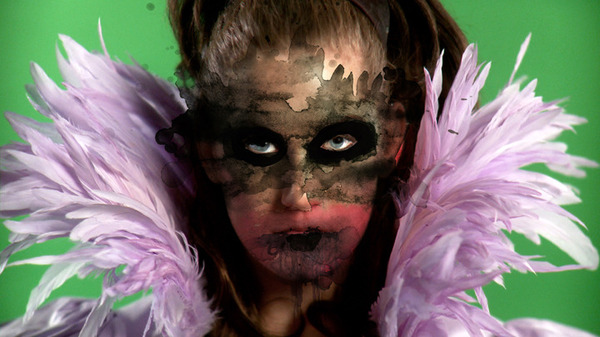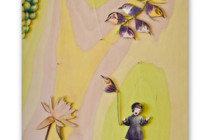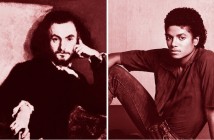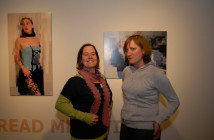Running a scenic course under the overpass of cross-dressing, “Virtuoso Illusion,” hits all the usual but gleaming notes typical to the theme: The vibrantly melancholic Sedgwykean Hero(ine), tales of excess (both cautionary and leading), the refracted illuminations of appropriated self, and the underpinnings of what’s queer met with the subversive as a way of life; to begin a list. However, the show really achieves a coasting clip when all cultural presumptions fade and the complexly stacked fixtures of identity are in the fore.
During a panel discussion on the exhibition, guest curator Michael Rush chose his words carefully enough to arrive at the conclusion that these works, “…can’t be reduced by theme;” no matter how consistently or sparingly the pieces’ common notes are hit. One of three Artists asked to speak on the panel, Michelle Handelman, seconded Rush’s assertion while trying to explain the nuts and bolts of her piece “Dorian,” based on Oscar Wilde’s, A Picture of Dorian Grey. The actor playing the lead and film’s namesake is, stated plainly, a women playing a man impersonating a woman in the classical drag queen sense. After already connecting the dots for the audience and much encouragement from Rush, Handelman surmised the situation at hand and nodded to the undesirable dismantling of identity by saying, “I’m part of this subculture as well… and it’s sort of a drag to teach.” Inadvertent pun in tow, Handelman’s statement reflects the dual levity and densely constituted matter that makes up most of the new media works in the exhibit. It could be sufficient to say that the modern persona retains the privilege of being seen through a viewfinder type lens where a defining aspect of self can be launched into prominence without the encumbering designations of permanence or priority.
Dorian in particular, carries you through the trajectory of acquired excess and spirit reduction (like Wilde’s classic), but via characters who are the inverted constructs of such a plot: Lovely blank slates constructed into intricately gloss-slicked mavens. Viewed on four panels of toggling footage, the enigmas of slop and serenity play concurrently throughout the work. Dorian runs amuck in what could be Paradox City, to an almost classical background of lacquered companions. Furthering a divergence from anything postulated by theme, Handelman evokes the classic “Peter and the Wolfe,” by representing the plot’s heavyweights with recurring, character-specific instruments. The statuesque Lord Henry (Armen Ra) is ushered in while playing a Theremin with his haunting grace maintained thereafter by its warbling song. A viola symbolizing Dorian, and albeit, a camera shutter for Basil, all propel the barely worded narrative into that of the operatic realm. All this contextual matter unfolds, while mature technical proficiency streamlines the video delivering diamond dripped decadence to stunning, breathe-holding effect.
Across the gallery and aesthetic spectrum is Ryan Trecartin’s video work K-Corea, INC.K(Section A). It holds hands with/dry-cough laughs-in the face of facsimile while eschewing structure. The piece catches a group of pangendered but uniformed megalomaniac blonds at the peak of their shrill pitch thirst for soliloquy. Though densely worded, the language used by the team is entirely obliterated. It’s a stream-of-capitalist riot that floods the viewer with mutated cultural coinage and just enough pejorative to grant you a smile from being gob smacked. On a plane, one blond asserts into her cellular, “There be smoking in the 3rd world class!” while another scene has the gem, “Where’s Globalese?” It speaks directly to a culture inundated with fluff-type data. The hollow vernacular implemented here whitewashes these very specific characters of persona and snatches away their humanity (in a funny way). The resulting voyage is a Tiffany bashing, nerve-cracked, ego stratification delivered at break-neck speeds.
Several mainstays of the gender bending approach remind us of the worth of warped self. John Kelly’s subdued drag performances make brilliant the technical nuance and beauty inherent in man’s replication of nature. His films let the audience dip in and out of mirrored perspectives to define their own sense of what is real. In sustained brevity we catch a glimpse of Warhol, calmly teetering on the edge of the 15 minute gulf he so eponymously dug. His face caked in foundation, the portrait series remains a flipbook of an epoch where fame was had and drag was smart. Kalup Linzy’s video offering has the same skeletal make up of whatever it is we value in the Eddie Murphy and Tyler Perry franchises but with a discerning wit. He masterfully ingests and returns an urban melodrama like an infant sponge so that each fadeout and bar-scene segue are matched, in pace and tone, with that of Melrose place. The very slight difference in product is hilarious.
Ultimately, that is the great thread intersecting the works in “Virtuoso Illusion.” With each piece the audience is allowed to compare and contrast what’s given with what’s created; resulting in sparks issued from what happens when identity is left fluid.
- Michelle Handelman, Dorian, four channel video installation.
- Ryan Trecartin, K-Corea, INC.K(Section A), video.
- Kalup Linzy, Conversations Wit de Churen, video.
"Virtuoso Illusion: Cross-Dressing and the New Media Avant-Garde" is on view through April 4, 2010 at MIT's List Visual Art Center.
All images are via Google.







